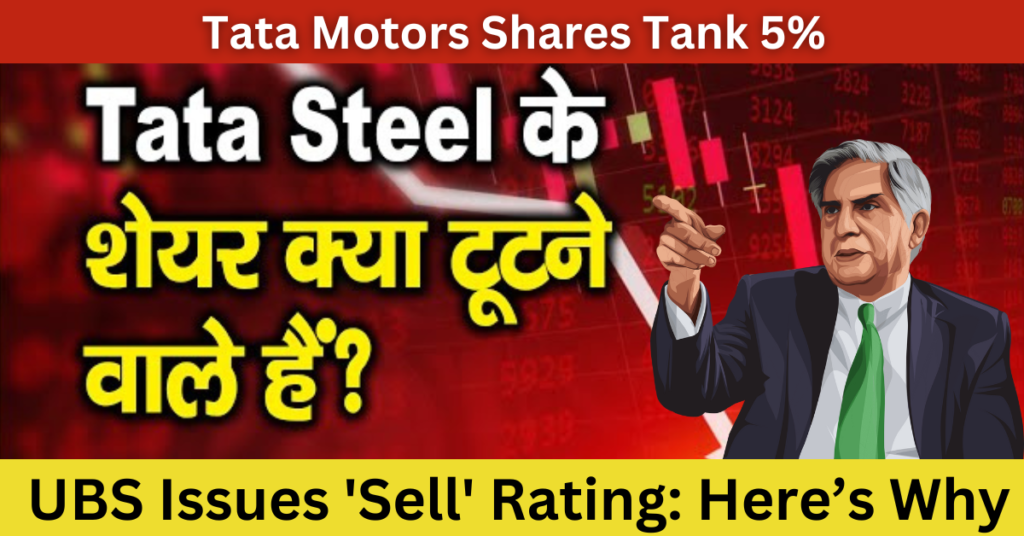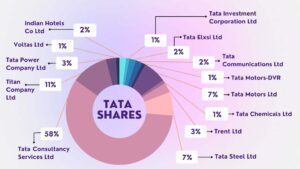
In a significant market development, Tata Motors Shares Ltd shares plunged nearly 5% on Wednesday, following a ‘Sell’ recommendation from the global financial services firm UBS. The brokerage has set a price target of Rs 825, which indicates a potential 20% downside from the previous day’s closing price. This comes amid concerns over the performance of Tata Motors’ premium Jaguar Land Rover (JLR) models and weakening demand in India for commercial and passenger vehicles.
Here’s a closer look at why UBS has taken a bearish stance on Tata Motors Shares and what this means for investors.
On Wednesday, Tata Motors Shares dropped 4.86%, hitting a low of Rs 985.15 on the BSE. The decline follows concerns raised by UBS over the company’s premium offerings through its JLR (Jaguar Land Rover) arm. JLR, particularly its high-end models such as the Range Rover, Defender, and Range Rover Sport, has been a key driver of Tata Motors’ average selling price (ASP) and gross margins. However, these models, which saw a successful run post-pandemic, are now facing a slowdown, with order backlogs dipping below pre-Covid levels.
The extended boom in JLR’s top-tier models has started to moderate, and UBS expects the company to face rising incentives and discounts to maintain demand.
Why UBS Downgraded Tata Motors: Reasons
1. Order Backlog Falling Below Pre-COVID Levels
Tata Motors’ JLR segment has been a major contributor to its financials, but its order book for models like the Range Rover and Defender has dropped below pre-pandemic levels. With incremental bookings lagging behind supply, UBS suggests that JLR may be forced to offer incentives and discounts on premium models, which had previously sold at near-zero discount levels.
UBS has warned that this trend could weaken JLR’s financial performance significantly in the upcoming fiscal years, especially by FY26. This slowdown in orders, combined with rising discounts, indicates that the strong momentum of the past two years might not be sustainable moving forward.

2. Rising Discounts on Premium Models
In 2023, Defender was the first model to see rising incentives. By July 2024, discounts on the Range Rover Sport also surged. Given that Range Rover Sport is one of JLR’s top-selling models in markets like the US, this could be a red flag for the company’s profit margins. The extended run of these models, which launched in 2022, is now showing signs of softening.
UBS pointed out that rising discounts could continue, impacting gross margins. Even in the short term, deliveries may be affected due to disruptions from flooding at one of JLR’s aluminum suppliers, further adding to the company’s troubles.
3. Impact of Semiconductor Shortages
JLR had previously rationed production during the semiconductor shortage, prioritizing higher-margin models like Range Rover. While this strategy helped protect margins, UBS warns that the ability to do so may no longer be as effective if demand continues to weaken and discounts become the norm.
The ASP (Average Selling Price) for JLR’s premium models expanded from £49,000 in FY20 to £72,000 in FY24, with gross margins improving from 26.7% to 31%. This sharp rise in profitability is now under threat due to declining demand, rising discounts, and moderating growth.
4. Weakness in Indian Market for Commercial Vehicles (CVs) and Passenger Vehicles (PVs)
The challenges for Tata Motors are not limited to its UK-based JLR arm. UBS also highlighted weaknesses in the Indian market, particularly in the Commercial Vehicles (CV) and Passenger Vehicles (PV) segments. Tata Motors’ CV sales are showing signs of weakness, while its PVs have started to underperform their regional peers in terms of growth and margins.
UBS values JLR at Rs 340, based on a 7 times one-year forward PE. For the Indian segments, CVs are valued at Rs 280 and PVs at Rs 170, based on 10 times and 14 times one-year forward EV/Ebitda, respectively.
5. EV Segment Under Pressure
UBS has also flagged concerns over Tata Motors Shares’ Electric Vehicle (EV) arm, which has been a key part of the company’s future strategy. Despite high expectations, UBS believes the EV segment may face performance challenges due to high valuations and potential shortfalls in delivering expected results.
The brokerage has indicated further downside risks if there’s any significant slippage in margins for JLR or the Indian PV segment, particularly on the EV front.
UBS’ Valuation and Recommendations
UBS has set a target price of Rs 825 for Tata Motors, implying a potential downside of 20% from Tuesday’s close. It values JLR at Rs 340 based on a forward price-to-earnings ratio of 7 times, while the Indian CV and PV segments are valued at Rs 280 and Rs 170, respectively.
UBS remains concerned about margin slippage and the potential for performance shortfalls, especially in the high-valuation segments like Indian PVs and EVs. Given the valuation and the challenges Tata Motors faces in both its international and domestic markets, UBS has recommended investors sell Tata Motors stock.
What This Means for Investors
The 5% drop in Tata Motors’ stock is a reflection of growing concerns over its premium JLR models, rising discounts, and a weakening Indian market for CVs and PVs. Investors who have seen strong returns from Tata Motors in recent years may need to reconsider their position in light of UBS’ downgrade and the anticipated pressure on margins and sales.
While the company’s strategy to capitalize on high-margin models like Range Rover has worked well during the semiconductor crisis, the moderation in demand and rising discounts suggest that the company may need to recalibrate its approach.
For investors looking to make decisions based on Tata Motors’ future performance, monitoring JLR’s sales trends, any new ICE/hybrid launches, and the evolution of discounts will be crucial.
The latest market movements for Tata Motors Shares reflect the growing uncertainty around its premium JLR models, as well as weak demand in its home market of India. With rising discounts, moderating growth, and UBS predicting further downside, investors may need to brace for more turbulence.
While the future of Tata Motors is far from certain, the company’s resilience and ability to innovate will play a critical role in how it navigates these challenges. For now, UBS has made its stance clear: Sell Tata Motors Shares before more downside risks materialize.

FAQ’s
1. Why did Tata Motors’ shares fall by 5%?
Tata Motors’ shares fell nearly 5% after UBS issued a ‘Sell’ recommendation, citing concerns over moderating demand for its Jaguar Land Rover (JLR) models and weakening performance in its commercial vehicle (CV) and passenger vehicle (PV) segments in India.
2. What is the new target price set by UBS for Tata Motors?
UBS has set a target price of Rs 825 for Tata Motors, implying a potential downside of 20% from its previous closing price.
3. What are the main concerns raised by UBS regarding Tata Motors?
UBS is concerned about the falling order backlog for JLR’s premium models, rising discounts, weakening demand in the Indian CV and PV markets, and potential margin slippage, particularly in the electric vehicle (EV) segment.
4. How is the Jaguar Land Rover (JLR) segment performing?
JLR’s premium models like the Range Rover and Defender have seen order backlogs drop below pre-COVID levels, and discounts on these models are expected to rise. This, along with moderating growth, is a concern for future financial performance.
5. What should investors do after UBS’ ‘Sell’ recommendation?
Investors should closely monitor Tata Motors’ performance, particularly the demand trends for JLR, the Indian CV and PV segments, and any developments in its EV business. It may be advisable to consult with a financial advisor before making any investment decisions.
Disclaimer: This article is for informational purposes only and should not be construed as financial advice. Always consult a certified financial advisor before making investment decisions.
People Also Read
- Bajaj Housing Finance IPO: Golden Opportunity is a Must-Consider Investment 2024
- Hindi Mai khoj:- Click Here


